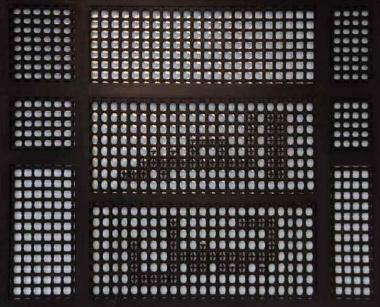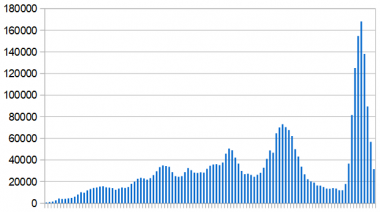Aissawa/ Aissaoua
The Aissawa, founded by Sidi Ben Aissa in the 15th century, are perhaps the best known of the Sufi brotherhoods of Morocco. This Aissawa group, led by Said Kissi, comprises 16 musicians onbendir, taarija(percussion instruments), raita (small pipes) andn'far(large one-note trumpets.
Andalusian music
Andalusian music traces its origins to Abu Hassan Ali Ben Nafi, known as Ziriab. This famous singer and composer fled Baghdad in the 9th century following injurious rumours and intrigue spread by his teacher, Ishaq al-Mawsili, who became jealous of his success.
Andalusian musicis characterised by a complicated musical structure. The lyrics are in Andalusian dialect "Gharnati" or classical Arabic. The late Cheikh Salah led one of the finest modern orchestras.
Andalusian classical music
Wikipedia
al-Andalus
A contemporary Andalusian music and dance by a group currently based in the US.Their artistic director is from Morocco and they have many Moroccan and Arab music influences in their music.The Arab West and Andalusia
CD review by Bahjat Qaqish
Bedouinmusic
Essentially, this is the music of the Arabian desert tribes. Often based on poetry and sun unaccompanied.
Berbermusic
The ancient Berber culture is extrordinarily rich and diverse, with a variety of musical styles. These range from bagpipes and oboe (Celtic style) to pentatonic music (reminiscent of Chinese music) - all combined with African rhythms and a very important stock of authentic oral literature.
These traditions have been kept alive by small bands of musicians who travel from village to village, as they have for centuries, to entertain at weddings and other social occasions with their songs, tales, and poetry.
To hear the sounds and find out more, visit theAzawan amazighwebsite, written in English, French and Berber, which is dedicated exclusively to Berber music. Those featured on the site include the great Berber singer, Ammuri Mbark. In the 1970s, with his group Usman, he was the first one to modernise Berber song - without removing its soul. There are also excerpts from the latest CD by Markunda Aures (Algeria), who is noted for her exceptional voice. Walid Mimoun (Rif, Northern Morocco) will be added shortly.
These artists tend to be ignored, or given only token recognition, in their own countries where the Arab-Islamic culture dominates.
Other Berber artists:
Born during the turbulent years of the French occupation in the 1950s,Umaluwas exposed early on to different ethnicities which gave him an appreciation of his multicultural environment. Later this influenced his approach to music: classical, Flamenco, French, and African Rai.
Master Musicians of Jajoukaare a large all-male group who play traditional music from the Rif mountains near Tangier.
Najat Aataboubecame a singer following a recording of her voice at a family celebration. She has since become a star in her native Morocco, speaking out against the religious and moral strictures of her family tradition.
Chaabi
Chaabi (also spelt "shaabi") is Arabic for "popular" or "of the people". It is basically pop music with Arab, African and western influences.
Arab pop began to develop in Egypt during the mid-1960s with songs that were sometimes humorous or risqué and often had nationalist themes. Favourite singers of the time included Aida al-Shah and Layla Nasmy. This early pop had a mainly middle-class appeal until the early 1970s when Ahmed Adaweyah broke through into the mainstream with a more edgy kind of music that emerged from the poor districts of Cairo and rebelled against respectable society.
In Morocco, the 1970s saw the emergence of several groups recognised as pop innovators including JilJilala, Nass El-Ghiwane and Lem Chaheb.
For many years Noujoum Ouazzawas the singer and guitarist for the cult-band Lem Chaheb, who decisively influenced the sound of the new North-African pop music in the 1970s and 1980s. Ouazza later joined the Dissidenten line-up.
Classical
Arab classical music is essentially theAndalusian musicof the 10th to 15th centuries. It is extremely complicated in musical structure, and its lyrics are characterised by the strict use of the Andalusian dialect or classical Arabic. Main instruments used are thetar, a form of tambourine; sometimes thedarbuqa, a funnel-shaped drum made of clay; and three types of stringed instruments - therebab, thekemanjah(a violin) and the'oud(a lute). For more about these, see al-bab'smusical instrumentspage.
Gharnati
Andalusian musicsung in the Gharnati dialect.
Gnawa/ Gnaoua
The Gnawa people originally came from the Guinea Empire (today Senegal, Guinea, Mali). During the 16th century, they were deported to North Africa as slaves of rich sultans and integrated this new culture and religion into their own. The music of theGnawais a powerful mixture of religious Arabic songs and African rhythms, trance music tinged with mysticism. Typical instruments used in Gnawa are thetbal(loud double-headed-drums) andquerqbat(metal castanets).
Essaouira Gnaoua and World Music Festival
Official website
How the Gnaoua Music Festival is making Morocco “African again”
Alexander Jusdanis. Muftah, 27 July 2017
Gnawa music offers songs with soul
By Saeed Saeed, The National, 7 August 2012
Griha
Griha is a form of popular music,using the colloquial, rather than the classical language. New songs are composed in this genre; they usually concern love, war and adventure - often including topical satire.
HeavyMetal
Rock and heavy metal
By Saeed Saeed, The National, 14 August 2012
Highway to hell
Heavy metal fans in some Arab countries don't just fear noise complaints from neighbours. They risk being imprisoned as devil worshippers. By Brian Whitaker, The Guardian, 2 June, 2003
Moroccan heavy metal fans jailed
BBC, 7 March, 2003
Hip-hop
Arabic hip-hop
By Saeed Saeed, The National, 10 July 2012
al-Jeel / al-Jil
Arabic for "the generation" - presumably the younger generation. A type of dance pop using synthesisers but with a distinctively Arab sound. It originated in the 1970s and one of its most influential early exponents was Hamid el-Shaeri. Born in Benghazi, Libya, Shaeri studied aviation in Britain and music in Cairo.He moved permanently to Egypt in 1974 after the Libyan leader, Colonel Gaddafi organised a ceremonial burning of western musical instruments.
Khaleeji
Music typical of the Arab Gulf states.
History and development of Khaleeji music
By Saeed Saeed, The National, 24 July 2012
Malhun/ Melhun
Malhun is a kind of urban, sung poetry that comes from the exclusively masculine working-class milieu of craftsmen's guilds.
Malouf
A derivative ofAndalusian musicfound in Tunisia.
The musical pulse of Tunisia
Article about themaloufgenre, by Thorne Anderson(Saudi Aramco World)
Ra'i
Ra'i (meaning "opinion" in Arabic) mixes western technology with a traditional music line and colloquial Arabic vocals. It came originally from Algeria, where it was banned on the radio until 1985. Besides provoking the government, it angered Islamists with its lyrics. Most of its best-known performers now live in France. One of them - Cheb Hasni - was assassinated.
Rai
By Saeed Saeed, The National, 17 July 2013
Rap
Hip-hop on the frontline
Globalised rap music may have lost its bite, but in the Middle East it's giving voice to both sides in the conflict. By Mark Espiner, The Guardian, 26 October, 2004
Sa'idi/ Sayidi music
Folk music from the upper Nile. Popular performers includeLes Musiciens du Nil, Shoukoukou, Ahmed Ismail, Omar Gharzawi, Sohar Magdy and Ahmed Mougahid.
Sawt
Sawt is Arabic for "sound" or "voice". It is a popular form of urban music in the Gulf, especially Kuwait and Bahrain. Usually performed with 'oud, mirwas and violin.
Sephardicmusic
Traditional music of the Sephardic Jews, often withAndalusianinfluences.
Shaabi
SeeChaabi



